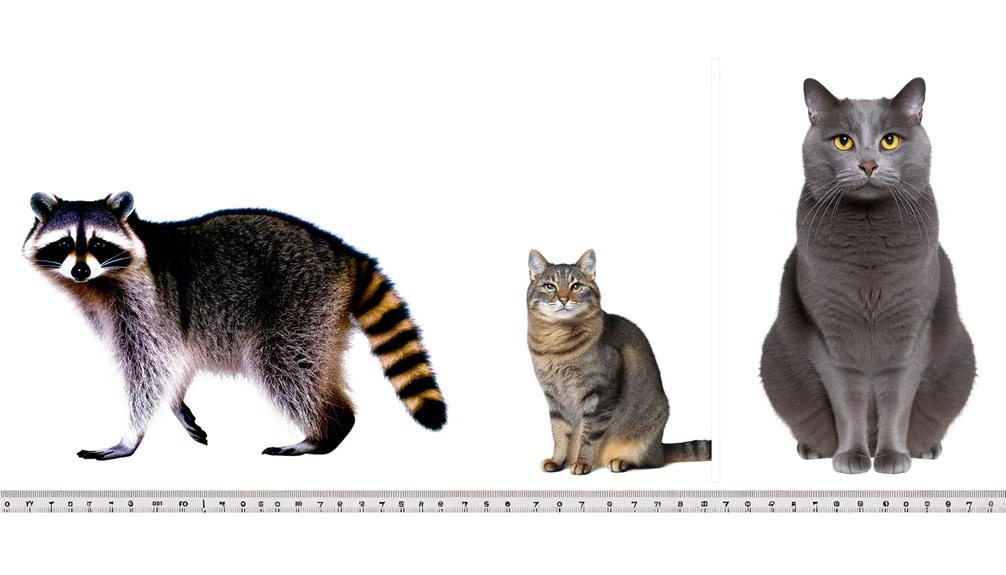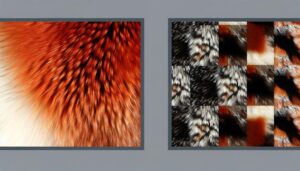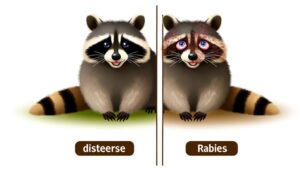7 Big Differences in Size When Raccoons Are Compared to Cats
Raccoons are generally larger and robust when compared to domestic cats, with adults typically weighing between 14-23 pounds and measuring 16-28 inches in body length. On the contrary, average domestic cats range from only 6-16 pounds, and, excluding the tail, they extend to around 9.1-9.8 inches in length.
These disparities in size are dictated by a variety of environmental, dietary, and genetic factors. The behavioral differences between raccoons and cats, influenced by their respective sizes, provide an intriguing contrast, a deeper exploration of which offers valuable insights into their urban and wild habitats.

Key Takeaways
- Raccoons are generally larger than cats, with adult raccoons typically weighing 14-23 pounds versus cats' 8-10 pounds.
- A raccoon's body length ranges from 16-28 inches, while a domestic cat's body length is typically 18-20 inches, excluding the tail.
- Urban raccoons tend to be larger than wild raccoons due to abundant food sources, whereas cat sizes can vary due to breed, age, and diet.
- Raccoons' larger size contributes to their aggressive and territorial behavior, while cats rely on agility and stealth due to their smaller size.
- Raccoons continue to grow until about 3-4 years of age, contributing to their size variety in the wild, while cats grow rapidly in their first year.
Understanding Raccoon Anatomy
To fully understand the similarities and differences between raccoons and cats, it is essential to first examine an in-depth analysis of raccoon anatomy, which is characterized by several unique and remarkable features.
With an average body length of 16-28 inches, raccoons possess a robust structure that is complemented by an additional 8-16 inches of bushy tail.
Their anatomy is further distinguished by hand-like forepaws that grant raccoons impressive dexterity, enabling them to open jars, turn doorknobs, and climb with ease.
Furthermore, their sharp, carnivorous teeth and enhanced night vision equip them for both predatory and scavenging roles.
To conclude, raccoons boast a dense coat that provides insulation during harsh winters, embodying their adaptability to diverse environments.
Overview of Cat Sizes
The size of cats, particularly domesticated ones, varies considerably and is influenced by an array of factors.
The average dimensions of domesticated felines will be quantified, providing a baseline for comparison.
Beyond this, the discussion will extend to explore the various elements that result in size disparities, such as breed, genetics, and environmental factors.
Average Domestic Cat Sizes
How large, one might ask, does the average domestic cat typically grow?
Scientifically, the average domestic cat, which belongs to the species Felis catus, typically weighs between 8 to 10 pounds and measures about 9.1 to 9.8 inches in height at the shoulder. The body length, excluding the tail, usually spans between 18 and 20 inches. The tail length can add an additional 11 to 12 inches, creating a total length ranging from 29 to 32 inches.
These measurements, however, are averages and there can be considerable variations based on factors such as breed, age, diet, and health.
One must also consider the influence of domestication, as human intervention in breeding practices can lead to size variations within the species.
Size Variations in Cats
Remarkably, one can observe a wide range of size variations in the Felis catus species, with the smallest breed typically weighing just 5 pounds and the largest reaching a hefty 20 pounds. This variation is noteworthy, denoting a fourfold difference in weight between the smallest and largest breeds.
This wide range in size is a reflection of the genetic diversity within the Felis catus species, allowing for a variety of physical attributes and weights. It's essential to mention that while weight is a useful metric for sizing, it doesn't capture the entirety of a cat's physical proportions.
Other parameters, like body length, height, and skeletal structure, also contribute to the overall size of a cat, and vary significantly across different breeds. This analysis only scratches the surface of size variation within cats.
Factors Influencing Cat Size
Expanding on our exploration of feline size, it's important to take into account the numerous factors that contribute to these variations, including genetics, diet, and environment. The role of these elements in determining the size of a cat varies, but they all play a vital part in the overall outcome.
- Genetics: Certain breeds naturally grow larger or smaller based on their genetic makeup.
- Diet: The nutritional intake of a cat can impact its growth and size. Cats fed with a balanced diet tend to be healthier and adequately sized.
- Environment: Cats living in conducive environments typically grow larger than those in harsh conditions.
- Health: A cat's health, including any underlying medical conditions, can influence its size.
Careful observation and understanding of these factors can assist in predicting the potential size of a cat.
Comparing Average Weights
In evaluating the average weights of raccoons and cats, it is pertinent to note that the measurements can vary substantially due to factors such as species, age, and habitat.
Typically, a mature raccoon can weigh between 11 to 57 pounds, while domestic cats usually range from 6 to 16 pounds.
A detailed comparison and analysis of these weight ranges will provide a clear understanding of the physical disparities between the two species.
Average Raccoon Weight
To draw a comparison between raccoons and cats, it is important to take into account their average weights, with adult raccoons typically weighing between 14 to 23 pounds, a significant contrast to the average domestic cat which weighs between 8 to 10 pounds.
- Raccoons, due to their omnivorous diet and semi-aquatic lifestyle, have evolved to develop a bulkier body mass.
- Their weight can be visually compared to a small or medium-sized dog, rather than a domestic cat.
- This weight difference is also reflected in their body structure, with raccoons having a sturdier, more muscular build.
- The weight of a raccoon can also affect its behavior, agility, and adaptability, differentiating it from feline counterparts.
This stark contrast in weight gives insight into the different lifestyles and survival strategies of these two species.
Typical Cat Weight
Delving into the usual weight range for domestic cats, studies reveal that they generally tip the scales at a svelte 8 to 10 pounds, a figure much lower than that of raccoons. This data is derived from extensive studies carried out by leading researchers worldwide. It is worth noting that these figures account for adult cats in prime health and may vary based on factors such as breed, diet, and lifestyle.
| Breed | Average Weight (lbs) | Weight Range (lbs) |
|---|---|---|
| Siamese | 8.5 | 7 – 10 |
| Persian | 9.5 | 8 – 11 |
| Maine Coon | 12.5 | 10 – 15 |
| Domestic Short Hair | 9.5 | 8 – 11 |
This table represents a selection of common cat breeds and their usual weights. Other breeds may fall outside this range.
Weight Comparison Analysis
Drawing a comparison between the average weights of raccoons and domestic cats presents a remarkably contrast, with raccoons typically outweighing cats by a significant margin.
- The average weight of an adult raccoon can range between 14 to 23 lbs, showcasing their robust nature.
- In comparison, domestic cats typically weigh between 7 to 10 lbs, displaying a more delicate physique.
- The substantial weight difference can be attributed to the raccoon's omnivorous diet and adaptive nature, causing them to bulk up more.
- Surprisingly, despite this significant weight disparity, both species share similar agility and climbing skills.
This data renders a vivid image of the physical contrasts between these two species, highlighting the raccoon's superior weight.
This analysis underlines the importance of considering the weight factor when comparing these two animals.
Size Differences: Length
Examining the length of these creatures, raccoons typically measure between 16 to 28 inches from nose to tail base, while cats, on average, are slightly shorter, with a body length ranging from 9.1 to 9.8 inches excluding their tail.
This notable disparity in length is due, in large part, to the evolutionary adaptations both species have undergone to thrive in their respective habitats. Raccoons, being omnivorous creatures that forage in a diverse array of environments, have evolved a longer body to aid in their search for food. Cats, on the other hand, are primarily domesticated animals, and their shorter length aids in their agility and nimbleness, necessary characteristics for their playful behavior and predatory instincts.
This examination underscores the fascinating, complex nature of animal morphology.
Height: Raccoons Vs Cats
In the domain of height, a noteworthy divergence between raccoons and cats is evident, with adult raccoons generally standing taller at 9 to 12 inches, as opposed to the average domestic cat's height of 9.1 to 9.8 inches when measured at the shoulder. This height discrepancy is mainly due to the difference in leg length and body structure between the two species.
To illustrate:
- Raccoons, with their robust and compact bodies, have relatively long legs that account for their heightened stature.
- Cats, on the other hand, exhibit a sleeker, more streamlined body form, with proportionately shorter legs.
- The shape of a raccoon's foot, which is longer and flatter, also contributes to its taller height.
- Conversely, a cat's paw, being more rounded and compact, does not notably add to its overall height.
This analysis underscores how differing anatomical adaptations can greatly affect relative height measurements in animal species.
Raccoon and Cat Lifespan
Shifting the focus to life expectancy, a detailed comparison reveals significant disparities in the average lifespan between raccoons and domestic cats. Lifespan in these species is influenced by factors such as genetics, environmental conditions, and human intervention.
| Species | Average Lifespan in Captivity | Average Lifespan in the Wild |
|---|---|---|
| Raccoons | 20 years | 2-3 years |
| Domestic Cats | 15 years | 7 years |
The table above indicates that raccoons tend to live longer in captivity than domestic cats, but have a shorter lifespan in the wild. This is attributable to the harsher conditions and greater predatory threats they face in the wild. Domestic cats, on the other hand, have evolved into effective urban survivors, hence they can live longer in the wild compared to raccoons.
Factors Influencing Raccoon Size
Delving into the matter of size, numerous factors come into play when analyzing the dimensions of a raccoon. These include their diet, genetics, environment, and age.
- Diet: Raccoons are omnivores, and their diet can greatly influence their size. Consumption of high-calorie human food can lead to obesity, causing them to exceed their natural size.
- Genetics: Just like in humans, a raccoon's genetic makeup can predispose them to be larger or smaller than average.
- Environment: The availability of food and territory size in a raccoon's habitat can also impact their growth and overall size.
- Age: Raccoons continue to grow until about 3-4 years of age. Consequently, an older raccoon will generally be larger than a younger one.
These factors intertwine, jointly dictating a raccoon's size and contributing to the wide variety observed in the wild.
Factors Influencing Cat Size
Turning our attention to cats, a host of distinct elements including diet, genetics, environment, and age, similarly govern their size and growth patterns. Nutrition plays a pivotal role, where a balanced diet rich in proteins and fats can greatly influence a cat's size.
Genetics define the breed-specific size boundaries, as some breeds tend to be more substantial than others. Environmental factors, such as exposure to exercise and space, can impact the physical development. Age, of course, determines the stage of growth, with kittens growing rapidly in their first year.
However, spaying or neutering at an early age can alter this growth pattern. These factors interplay in complex ways to determine a cat's size, providing a spectrum of sizes within the species.
Urban Versus Wild Raccoons
Drawing a parallel to the factors influencing cat size, it is intriguing to investigate similar disparities in raccoon populations, specifically within urban and wild environments. Urban raccoons tend to be larger due to an easily accessible abundance of food, while their wild counterparts, having to actively hunt for sustenance, are often smaller.
To further illustrate these disparities, consider the following:
- Urban raccoons often have access to human waste, providing an ample food source.
- Wild raccoons need to expend more energy to forage and hunt, which can limit their growth.
- Urban environments may offer more shelter and safety, contributing to increased lifespan and size.
- Wild raccoons are exposed to more predators, harsh weather, and food scarcity, factors that can influence their overall size.
Each environment distinctly shapes these creatures in their pursuit of survival.
Domestic Vs Feral Cats
As we shift our focus to domestic and feral cats, we will primarily concentrate on three significant factors: size, behavior, and lifespan. Scientifically comparing these aspects will provide a thorough understanding of how domestication and the wild influence these feline species.
This comparison will enhance the broader scope of our study, which contrasts raccoons and cats.
Size Comparison: Domestic Vs Feral
Comparing the sizes of domestic and feral cats, it's apparent that a variety of factors, including diet, environment, and genetics, can greatly influence their physical dimensions. Domestic cats typically weigh between 10 and 12 pounds, while feral cats can range from 4 to 15 pounds depending on access to food resources and environmental conditions.
- Domestic cats often have balanced diets provided by their owners, which can contribute to their larger size.
- Feral cats typically have a wider range in size due to inconsistent food sources.
- The environment, including exposure to harsh weather conditions, can affect a feral cat's size and weight.
- Genetic differences may also play a role, with certain breeds of domestic cats naturally larger than others.
This comparison helps us understand the significant variance that can occur between different cat populations.
Behavior: Domestic Vs Feral
In scrutinizing the behavioral differences between domestic and feral cats, it becomes clear that factors such as human interaction, habitat, and survival instincts play essential roles in shaping their respective behaviors. Domestic cats, nurtured in human homes, are often more sociable and less skittish. They rely on their human caregivers for food and safety. Feral cats, however, have not been socialized with humans, and their behaviors reflect their need to survive in the wild.
The table below demonstrates these differences:
| Behavior | Domestic Cats | Feral Cats |
|---|---|---|
| Interaction with Humans | Sociable | Skittish |
| Source of Food | Human-provided | Hunted |
| Sleeping Habits | Indoors, safe | Outdoors, vigilant |
| Reaction to Threats | Runs and hides | Fights or flees |
| Social Structure | Solitary or in family groups | Often in colonies |
These behavioral traits clearly delineate between the domestic and feral subsets of the species.
Lifespan: Domestic Vs Feral
When analyzing the lifespan of domestic and feral cats, it becomes evident that factors such as diet, healthcare, and exposure to hazards significantly influence the average longevity of these animals.
- A well-balanced diet, often provided by pet owners, ensures domestic cats receive necessary nutrients, contributing to an average lifespan of 13-17 years.
- Access to routine and preventive healthcare, including vaccinations and check-ups, also extends domestic cats' lives.
- Feral cats, however, lack these advantages. Their lifespan ranges typically from 2-5 years due to poor diet and health.
- Living in the wild exposes feral cats to weather extremes, predators, and diseases, further reducing their lifespan.
Understanding these factors can guide actions to improve feral cats' life expectancy, enabling us to respect all life forms' freedom.
Impact of Size on Behavior
The relative size of raccoons and cats plays a significant role in influencing their respective behavioral patterns. Raccoons, generally larger and more robust than cats, display behaviors indicative of their size such as aggressiveness and territoriality. Their larger size allows them to engage in confrontational interactions and compete for resources more effectively.
On the contrary, cats, being smaller, often exhibit behaviors that highlight their agility and stealth. Their smaller size enables them to move quickly and silently, often opting for evasion rather than direct confrontation. However, it's important to note that these behaviors also depend on other factors, such as individual temperament and environment.
Therefore, while size influences behavior, it is not the sole determinant.
Conclusion
To sum up, raccoons and cats exhibit significant size disparities, shaped by factors such as environment and domestication.
Raccoons generally outweigh and outsize cats, with particular variance in urban versus wild populations.
Despite these physical differences, both species exhibit remarkably adaptive behavior, underscoring the complexity and diversity of the animal kingdom.
Further research into these fascinating creatures may illuminate the intricate link between physical attributes and behavioral patterns in both species.






